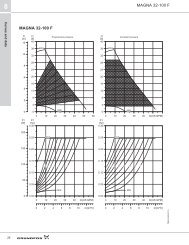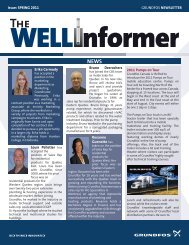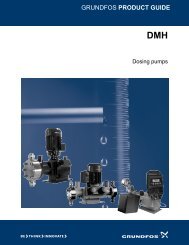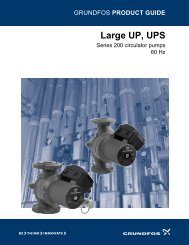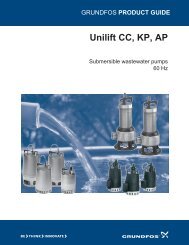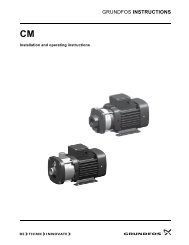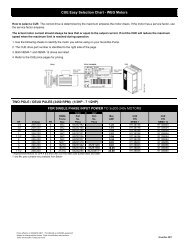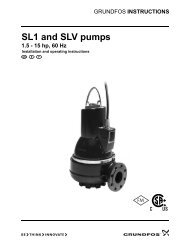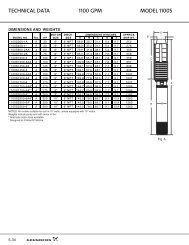CR, CRI, CRN, CRE, CRIE, CRNE - Grundfos Canada
CR, CRI, CRN, CRE, CRIE, CRNE - Grundfos Canada
CR, CRI, CRN, CRE, CRIE, CRNE - Grundfos Canada
You also want an ePaper? Increase the reach of your titles
YUMPU automatically turns print PDFs into web optimized ePapers that Google loves.
Selection and sizing<br />
<strong>CR</strong>, <strong>CR</strong>I, <strong>CR</strong>N, <strong>CR</strong>E, <strong>CR</strong>IE, <strong>CR</strong>NE<br />
Selection of pumps<br />
Selection of pumps should be based on<br />
• The duty point of the pump (see section 1)<br />
• Sizing data such as pressure loss as a result of<br />
height differences, friction loss in the pipework,<br />
pump efficiency etc. (see section 2)<br />
• Pump materials (see section 3)<br />
• Pump connections (see section 4)<br />
• Shaft seal (see section 5).<br />
1. Duty point of the pump<br />
From a duty point it is possible to select a pump on the<br />
basis of the curve charts in the section Performance<br />
curves/Technical data starting on page 26.<br />
H<br />
[m]<br />
300<br />
280<br />
260<br />
240<br />
220<br />
200<br />
180<br />
160<br />
140<br />
120<br />
100<br />
80<br />
60<br />
40<br />
20<br />
0<br />
H<br />
[ft]<br />
1000<br />
-11-2<br />
<strong>CR</strong>(E) 32<br />
950<br />
-10<br />
<strong>CR</strong>N(E) 3 2<br />
900<br />
-10-2<br />
2-pole, 60 Hz<br />
850<br />
-9<br />
800<br />
-9-2<br />
750<br />
-8<br />
-8-2<br />
700<br />
650<br />
-7<br />
-7-2<br />
600<br />
550<br />
-6<br />
-6-2<br />
500<br />
-5<br />
450<br />
-5-2<br />
400<br />
-4<br />
350<br />
-4-2<br />
300<br />
-3<br />
250<br />
-3-2<br />
200<br />
-2<br />
-2-1<br />
150<br />
-2-2<br />
100<br />
-1<br />
-1-1<br />
50<br />
0<br />
0 20 40 60 80 100 120 140 160 180 200 Q [US GPM]<br />
0 5 10 15 20 25 30 35 40 45 Q [m3/h ]<br />
P2 P2<br />
[kW ] [hp]<br />
4<br />
Eff<br />
P2 1/1<br />
3<br />
P2 2/3<br />
2<br />
2<br />
1<br />
1<br />
0 0<br />
0 20 40 60 80 100 120 140 160 180 200 Q [US GPM]<br />
H NPSH<br />
[m] [ft]<br />
30<br />
8<br />
20<br />
4<br />
10<br />
NPSHR<br />
0 0<br />
0 20 40 60 80 100 120 140 160 180 200 Q [US GPM]<br />
Fig. 17 Example of a curve chart<br />
2. Sizing data<br />
When sizing a pump the following must be taken into<br />
account.<br />
• Required flow and pressure at the point of use.<br />
• Pressure loss as a result of height differences<br />
(H geo ).<br />
• Friction loss in the pipework (H f ).<br />
It may be necessary to account for pressure loss in<br />
connection with long pipes, bends or valves, etc.<br />
• Best efficiency at the estimated duty point.<br />
• NPSH value.<br />
For calculation of the NPSH value, see Minimum<br />
inlet pressure - NPSHA on page 24.<br />
H<br />
[ft]<br />
1000<br />
950<br />
900<br />
850<br />
800<br />
750<br />
700<br />
650<br />
600<br />
550<br />
500<br />
450<br />
400<br />
350<br />
300<br />
250<br />
200<br />
150<br />
100<br />
50<br />
0<br />
Eff<br />
[%]<br />
80<br />
60<br />
40<br />
20<br />
0<br />
H<br />
[ft]<br />
30<br />
20<br />
10<br />
0<br />
TM02 0039 1303<br />
H geo<br />
H f<br />
Fig. 18 Sizing data<br />
Efficiency<br />
Before determining the point of best efficiency the<br />
operation pattern of the pump needs to be identified. Is<br />
the pump expected to operate at the same duty point,<br />
then select a <strong>CR</strong> pump which is operating at a duty<br />
point corresponding with the best efficiency of the<br />
pump.<br />
H<br />
[m]<br />
300<br />
280<br />
260<br />
240<br />
220<br />
200<br />
180<br />
160<br />
140<br />
120<br />
100<br />
80<br />
60<br />
40<br />
20<br />
0<br />
Fig. 19 Example of a <strong>CR</strong> pump’s duty point<br />
As the pump is sized on the basis of the highest<br />
possible flow, it is important to always have the duty<br />
point to the right of the optimum efficiency point (see<br />
fig. 20, range with check mark). This must be<br />
considered in order to keep efficiency high when the<br />
flow drops.<br />
eff<br />
Fig. 20 Best efficiency<br />
NPSHR<br />
Required flow,<br />
required pressure<br />
H<br />
[ft]<br />
1000<br />
-11-2<br />
<strong>CR</strong>(E) 32<br />
950<br />
-10<br />
<strong>CR</strong>N(E) 3 2<br />
900<br />
-10-2<br />
2-pole, 60 Hz<br />
850<br />
-9<br />
800<br />
-9-2<br />
750<br />
-8<br />
-8-2<br />
700<br />
650<br />
-7<br />
-7-2<br />
600<br />
550<br />
-6<br />
-6-2<br />
500<br />
-5<br />
450<br />
-5-2<br />
400<br />
-4<br />
350<br />
-4-2<br />
300<br />
-3<br />
250<br />
-3-2<br />
200<br />
-2<br />
-2-1<br />
150<br />
-2-2<br />
100<br />
-1<br />
-1-1<br />
50<br />
0<br />
0 20 40 60 80 100 120 140 160 180 200 Q [US GPM]<br />
0 5 10 15 20 25 30 35 40 45 Q [m3/h ]<br />
P2 P2<br />
[kW ] [hp]<br />
4<br />
Eff<br />
P2 1/1<br />
3<br />
P2 2/3<br />
2<br />
2<br />
1<br />
1<br />
0 0<br />
0 20 40 60 80 100 120 140 160 180 200 Q [US GPM]<br />
H NPSH<br />
[m] [ft]<br />
30<br />
8<br />
20<br />
4<br />
10<br />
NPSHR<br />
0 0<br />
Optimum point<br />
H<br />
[ft]<br />
1000<br />
950<br />
900<br />
850<br />
800<br />
750<br />
700<br />
650<br />
600<br />
550<br />
500<br />
450<br />
400<br />
350<br />
300<br />
250<br />
200<br />
150<br />
100<br />
50<br />
0<br />
Duty<br />
point<br />
Best<br />
efficiency<br />
Eff<br />
[%]<br />
80<br />
60<br />
40<br />
20<br />
0<br />
H<br />
[ft]<br />
30<br />
20<br />
10<br />
0<br />
US GPM<br />
TM02 6711 1403<br />
TM02 0039 1303<br />
TM02 8579 0504<br />
21



